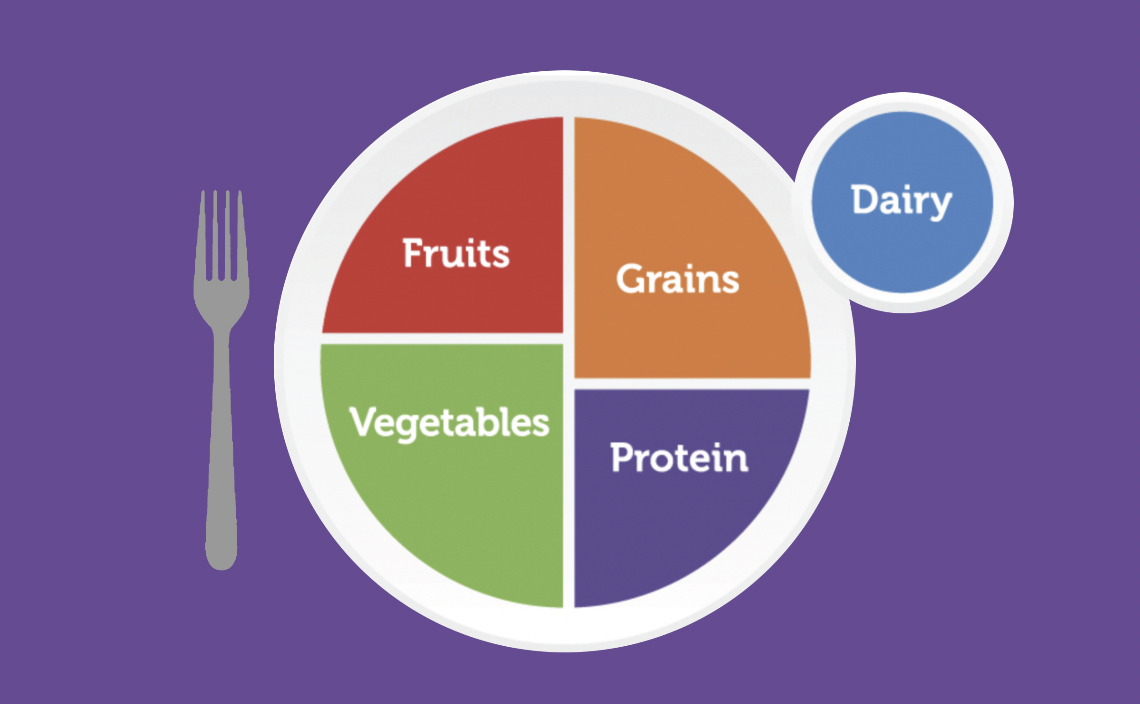By Karnie Babikian, Nutrition Educator at Uplift Therapy Center
The Dietary Guidelines for Americans (DGAs) are nutrition recommendations that help us follow a dietary pattern that is both healthy and enjoyable. MyPlate is the current nutrition guide that is based on recommendations from the DGAs and is the official symbol for the 5 important food groups: fruits, vegetables, grains, protein, and dairy. The MyPlate symbol looks like a real plate because it helps us put together complete meals, but it is also a representation of an overall healthy dietary pattern.
The recommendations from MyPlate can be applied to nutrition for every life stage, including your little ones! These recommendations promote a “bite-by-bite” approach, meaning that a healthy eating pattern has a positive effect that adds up over a lifetime, one bite at a time. MyPlate teaches the what and how much of foods and beverages for your children and helps put nutritious and complete meals together. Well-balanced meals ensure that your child is receiving the nutrients for proper growth and disease prevention.
It is important to note that the MyPlate guidelines are general recommendations. Not all meals that children eat will look like the MyPlate– some days, meals might consist of mostly grains (cereal, crackers) and other days, mostly fruits. That is ok! What’s important is that your child’s diet be balanced over the course of a week. A balanced diet is one that includes foods from all food groups in appropriate quantities for your child’s age. MyPlate can be a useful guide for you as a parent to assess generally if your child is getting all the nutrients that they need.
A breakdown of each food group:
FRUITS and VEGETABLES
Fruits and vegetables both contain nutrients that are necessary for your child’s health: fiber and an array of vitamins and minerals. Fiber is important for gut health and reducing constipation, while vitamins and minerals help strengthen the immune system. Consuming fruits and vegetables can reduce risk of many chronic illnesses, such as obesity, diabetes, and certain types of cancer. There are unique nutrients in different fruits and vegetables that give them their different colors– like the orange color of carrots or the blue color of blueberries! These nutrients that give fruits and vegetables color, also give them their distinct health benefits, which is why it is recommended to ‘eat the rainbow’ or eat a variety of fruits and vegetables.
GRAINS
Grains include foods made with wheat, rice, oats, or other cereal grains. Some of the foods in the grain group include bread, cereal, rice, noodles, pasta, and tortillas. Grains, particularly whole grains, are a great source of complex carbohydrates, fiber, vitamins, and minerals. Whole grains are just what they sound like – the whole or entire grain kernel! This includes the bran, germ, and endosperm. These structures are what give whole grains their nutritional value. Refined grains, on the other hand, undergo a process that removes these parts of the kernel. While this is done to improve texture and shelf life, this process removes the dietary fiber, iron, and many B vitamins. It is recommended that half of all grains consumed be whole.
PROTEIN
Proteins are the building blocks for the entire human body. Foods high in protein are important for maintaining bodily functions and supporting appropriate growth. Protein-rich foods contribute to all types of processes including muscle formation, hormone production, and transport of nutrients throughout the body. This food group consists of animal-sourced foods such as chicken, beef, or cheese, but it also includes non-animal sources like legumes, beans, lentils, nuts and nut butters. Even though non-animal sources of protein are plant-based, they can still have high protein content!
DAIRY
The dairy food group includes cow milk, yogurt, cheese, lactose-free milk as well as fortified soy milk and yogurt. Dairy provides calcium, fat, protein, vitamin D and other important nutrients such as Zinc and Potassium important for healthy growth and development. Calcium and Vitamin D strengthen bones and teeth, and healthy fats aids in brain development and cognition. It is important to note that non-dairy alternatives must be fortified with calcium in order to be considered a proper dairy replacement.
| Food Group | Foods Included | Serving Sizes |
| FRUITS | Any fruit or 100% fruit juice counts as part of the Fruit Group. Fruits may be fresh, canned, frozen, or dried; and may be whole, cut-up, or puréed. | 1 cup of fruit
1 cup 100% fruit juice ½ cup of dried fruit |
| VEGETABLES | Any vegetable or 100% vegetable juice counts as a member of the Vegetable Group. Vegetables may be raw or cooked; fresh, frozen, canned, or dried/dehydrated; and may be whole, cut-up, or mashed. There are five Vegetable Subgroups: Beans and Peas, Dark Green, Red and Orange, Starchy, and Other Vegetables. | 1 cup of raw vegetables
1 cup cooked vegetables 1 cup vegetable juice 2 cups of raw leafy salad greens |
| GRAINS | Any food made from wheat, rice, oats, cornmeal, barley, or another cereal grain is a grain product. Bread, pasta, oatmeal, breakfast cereals, tortillas, and grits are examples of grain products.
Grains are divided into two subgroups: whole grains and refined grains |
1 oz-equivalent:
1 slice of bread 1 cup of ready-to-eat cereal ½ cup of cooked rice ½ cup of cooked pasta ½ cup of cooked cereal |
| PROTEIN | All foods made from meat, poultry, seafood, beans and peas, eggs, processed soy products, nuts, and seeds are considered part of the Protein Foods Group. Beans and peas are also part of the Vegetable Group. | 1 oz-equivalent:
1 ounce of meat 1 ounce poultry 1 ounce fish ¼ cup cooked beans 1 egg 1 tablespoon of peanut butter ½ ounce of nuts or seeds |
| DAIRY | All fluid milk products and many foods made from milk are considered part of this food group. Most Dairy Group choices should be fat-free or low-fat. Foods made from milk that retain their calcium content are part of the group. Foods made from milk that have little to no calcium, such as cream cheese, cream, and butter, are not considered to be in the Dairy Group. Calcium-fortified soymilk (soy beverage) is also part of the Dairy Group. | 1 cup of milk
1 cup yogurt 1 cup soy milk 1 ½ ounces of natural cheese |
How much of each food group should children be eating?
Serving sizes are the recommended amount of a given food that should be consumed. Each food group has their own standard serving size. For example, a serving size can be 1 cup of fruit, or ½ cup of cereal. The recommended number of servings to eat from each food group changes for each age group. For example, as an adult you might require 5 servings of fruit and vegetables in a day, while your 3-year-old toddler will require only 2 servings of fruit and vegetables per day.
Daily Recommended Amount by Age
| Food Group | 2-4 years old | 5-8 years old |
| Fruits | 1 -1 ½ cups | 1 to 2 cups |
| Vegetables | 1-2 cups | 1 ½ – 2 ½ cups |
| Grains | 3-5 oz. equiv. total grains
1.5 – 3 oz. equiv. whole grain |
4 to 6 oz. equiv. total grains
2 to 3 oz. equiv. total grains |
| Protein | 2 to 5 oz. equiv | 3 to 5.5 oz. equiv. |
| Dairy | 2 – 2 ½ cup | 2 ½ cup |
Source: https://www.myplate.gov/eat-healthy/what-is-myplate
Portion sizes are the actual amount that someone chooses to eat in one sitting for a meal or snack. The portions you serve yourself as an adult will look different than the one you serve your child. Portions can be small and frequent throughout the day, but ideally, they should total to the daily recommended serving of a given food. An easy rule of thumb for how much to serve on a plate at each meal or snack is 1 tablespoon of a food per year in age. For example, if your child is 3 years old you can serve 3 tablespoons of a grain, 3 tablespoons of a vegetable, and 3 tablespoons of a protein in a single meal.
A note for selective eaters
For parents of selective eaters, these daily recommended amounts might seem overwhelming and impossible to achieve. This is not uncommon! Each child learns to eat in different ways and at different paces. As mentioned previously, MyPlate is the standard nutrition guide, meaning it is ideally what your children will work towards accomplishing. For the time being, continue working on the volume of foods they are able to tolerate, and slowly work on introducing new foods to increase variety. Multivitamins can be a great way to ensure selective eaters are getting all the nutrients they need as we work through solving their feeding difficulties. We recommend speaking to your primary care provider if you suspect your child might benefit from a multivitamin supplement.
In summary, here is what to remember to establish a healthy diet for your child:
- Strive to make half the plate fruits and vegetables
- Vary fruits and vegetables by ‘eating the rainbow’
- Try to incorporate more whole grains like oatmeal, whole grain bread, and brown rice
- Mix up protein-rich foods to include both animal and non-animal sources: seafood, beans, lentils, nuts, meat, or poultry all count!
- Water and low-fat dairy are the best beverage options (whole milk for children under 2 years old)
If you have additional questions and would like to consult about Feeding Therapy with our Nutrition Educator at Uplift Therapy Center, give us a call at 818-864-6602.




